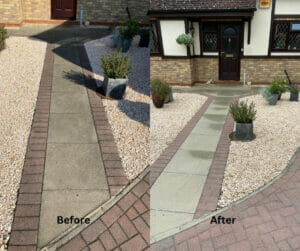Have you suddenly noticed orange marks on your concrete driveway and aren’t sure what they are… This blog will explore what causes rust stains on your concrete patio & driveway. In fact, we will look at the impact of lawn fertilisers on concrete and provide practical tips to protect your patios and driveways.
As a homeowner with a busy lifestyle and a passion for maintaining a beautiful lawn, it’s essential to be aware of the possible risks that lawn fertilisers can pose to your concrete patios and driveways. While fertilisers are vital in keeping your garden lush and green, they can also cause unsightly stains and damage to your concrete surfaces if not used and handled correctly.
Whether you’re a high-paid professional with a bustling social life or a retiree enjoying the serenity of your garden, this information will help you maintain the aesthetic appeal of your outdoor spaces.
Section 1: Understanding the Impact of Lawn Fertilizers on Concrete

-
Chemical Composition of Lawn Fertilizers.
Lawn fertilisers contain a variety of nutrients necessary for promoting healthy plant growth. These nutrients typically include nitrogen, phosphorus, and potassium. However, some fertilisers also contain iron compounds, which can lead to rust stains when they meet concrete surfaces.
-
Causes of Fertilizer Stains on Concrete
a) Overspill and Misapplication: Accidental overspill or improper application of lawn fertilisers can result in direct contact with concrete, leading to stains and discolouration. Following the recommended application instructions and using the appropriate tools to prevent overspill is essential.
b) Water Runoff: Excessive watering or heavy rainfall can cause the fertiliser to leach into surrounding areas, including patios and driveways. As the water evaporates, it leaves behind concentrated fertiliser residue that can stain the concrete.
Section 2: Preventive Measures to Safeguard Your Concrete Surfaces

-
Use a Drop Spreader or Handheld Spreader
When applying lawn fertiliser, opt for a drop spreader or handheld spreader rather than broadcasting it by hand. These tools provide better control, ensuring that the fertiliser stays on the intended areas of your lawn and minimising the risk of overspilling onto concrete surfaces. By using the appropriate spreader, you can target the fertiliser application more precisely and reduce the chance of accidental contact with the concrete.
-
Create a Barrier
Before fertilising, consider creating a physical barrier between your lawn and the concrete surfaces. Place plastic sheets or tarps along the edges of your patios and driveways to catch any stray fertiliser particles and prevent them from coming into direct contact with the concrete. This barrier is a protective shield, minimising the risk of stains and damage to your concrete surfaces.
-
Sweep or Rinse Off Excess Fertiliser
After fertilising, promptly sweep or rinse off any excess fertiliser that may have landed on your patios or driveways. This step helps prevent prolonged contact between the fertiliser and the concrete, reducing the risk of staining. Use a broom or hose to remove the loose fertiliser particles, ensuring they are not left to settle and potentially cause stains.
Section 3: Addressing Fertiliser Stains on Concrete

-
Immediate Cleaning
Acting fast is crucial if you notice fertiliser stains on your concrete surfaces. Start by rinsing the affected area with water to dilute and remove as much of the fertiliser residue as possible. Use a hose or pressure washer to direct a steady stream of water onto the stained areas, working from the outer edges towards the centre. This initial rinse will help loosen and remove the surface-level stains.
-
Bicarbonate of Soda Solution
Make a paste by mixing bicarbonate of soda (baking soda has bicarbonate in it and other ingredients, it can be used but not as good) with water to form a thick consistency. Apply the paste straight to the stained areas on your concrete surfaces. Using a soft brush or sponge, gently scrub the paste into the concrete, focusing on the stained areas. Bicarbonate of soda is a versatile and environmentally friendly cleaning agent known for its stain-removing properties. Its mild abrasive nature helps lift the stains from the concrete without causing damage. Allow the bicarbonate of soda paste to sit on the stains for about 10-15 minutes to penetrate and break down the stains further. Afterwards, rinse the area with clean water, thoroughly washing away all the paste and residue.
-
Commercial Concrete Cleaners
If the stains persist or are particularly stubborn, you may consider using a commercial concrete cleaner specifically formulated for stain removal. These cleaners are available in hardware stores, and they design to tackle tough stains on concrete surfaces. Read & follow the instructions given by the manufacturer carefully. Before application, test the cleaner on a small, inconspicuous area of the concrete to ensure compatibility and to check for any adverse reactions. Apply the cleaner to the stained areas as directed, scrub gently if necessary, and rinse with water to remove the cleaner and any loosened stains.
Section 4: Long-Term Maintenance of Concrete Surfaces

-
Regular Sealing
Applying a sealant to your concrete patios and driveways creates a protective barrier against stains and damage. Regularly check the condition of the sealant… reapply as necessary to maintain its effectiveness. Sealants provide an extra layer of protection, preventing fertiliser penetration and other substances that can cause stains. Consult with professionals or your local hardware store to select an appropriate sealant for your specific concrete surface and follow the manufacturer’s instructions for application.
-
Prompt Cleaning and Maintenance
Regularly clean your concrete surfaces to remove any dirt, debris, or potential fertiliser residue. Promptly address any spills or stains to prevent them from setting into the concrete. Use a broom or brush to sweep away dirt and debris regularly. Consider washing the concrete surfaces with water and a mild detergent periodically to keep them clean and free from stains. Additionally, be mindful of any spills or leaks, such as oil or other substances. Clean them up promptly to minimise the risk of staining.
By understanding the impact of lawn fertilisers on concrete surfaces and implementing preventive measures. You can enjoy a vibrant, healthy lawn while safeguarding the pristine appearance of your patios and driveways. Proper application techniques, quick cleaning, and regular maintenance will ensure your concrete surfaces remain free from unsightly stains. By utilising the natural cleaning power of bicarbonate of soda or seeking commercial concrete cleaners when needed, you can effectively tackle fertiliser stains on your concrete surfaces. With these tips, you can maintain an inviting outdoor space that complements your busy and fulfilling lifestyle.
If you’re looking for Patio & Driveway Cleaning Companies in Cambridgeshire, check out this blog:
 Written by Tracey Gilbey, Marketing and Admin Coordinator at Art of Clean.
Written by Tracey Gilbey, Marketing and Admin Coordinator at Art of Clean.
For further advice or information on our Carpet and Soft Furnishing care, please do not hesitate to contact the Art of Clean team on 01223 901551 in Cambridge. Our services include Carpet Cleaning, Upholstery Cleaning, and oriental and area Rug Cleaning. Curtain Cleaning, Patio, and Driveway Pressure washing. Leather Cleaning, Stone and Tile Floor Cleaning, and Wood Floor Sanding and Restoration. We also supply new flooring and carpets through our sister company, Art of Flooring. Our Dry-Cleaning service is provided by Farthings Cambridge.


